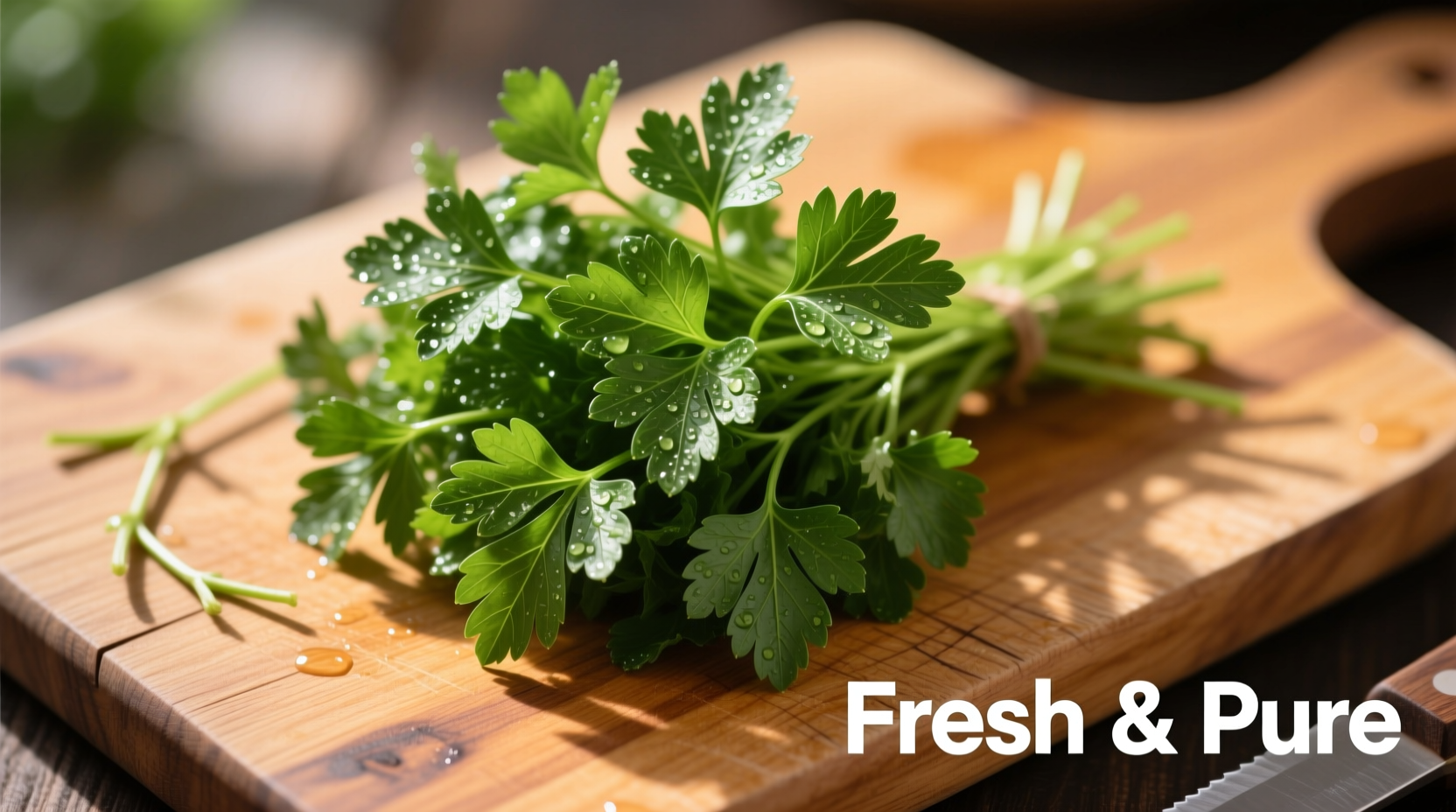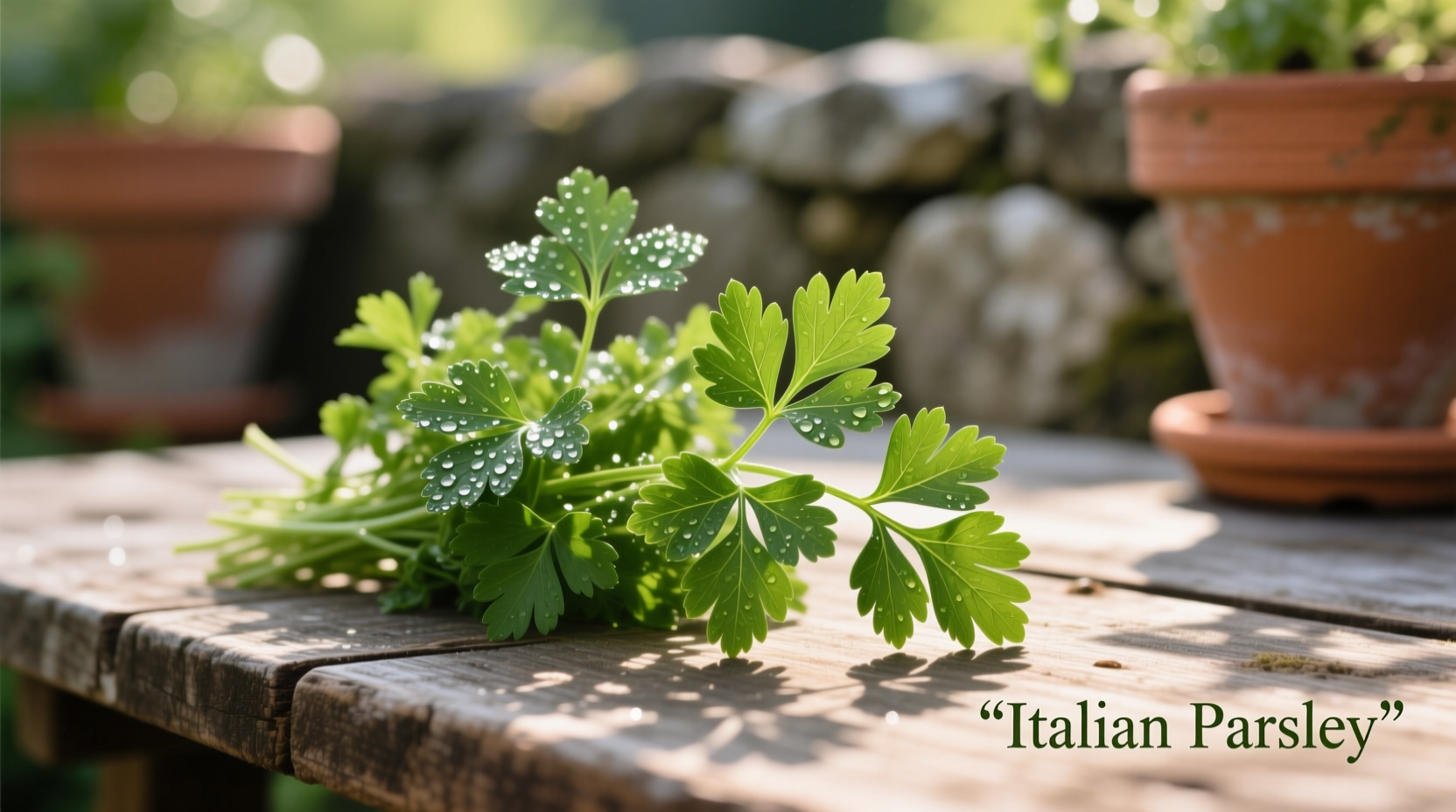When you reach for fresh herbs to elevate your cooking, Italian parsley stands apart as the professional chef's secret weapon. Unlike its curly counterpart often relegated to garnish duty, this flat-leaf variety delivers bold flavor that withstands cooking temperatures while enhancing dishes from pasta to grilled meats. Understanding its unique properties transforms how you approach seasoning and finishing dishes.
Identifying Italian Parsley: Visual Characteristics
Italian parsley features flat, dark green leaves with pointed tips and a slightly serrated edge. The stems are smooth and angular rather than rounded. When shopping, look for vibrant color without yellowing or wilting. Fresh Italian parsley should have a clean, grassy aroma with subtle peppery notes—never musty or bitter.
| Characteristic | Italian Parsley | Culinary Impact |
|---|---|---|
| Leaf Shape | Flat, pointed leaves | Easier to chop finely; integrates better into sauces |
| Flavor Profile | Bold, peppery, grassy | Withstands cooking; enhances savory dishes |
| Essential Oil Content | 25-30% higher than curly | More intense aroma and flavor retention |
| Heat Tolerance | Maintains integrity up to 15 minutes cooking | Can be added earlier in cooking process |
Historical Journey: From Medicinal Herb to Culinary Essential
Italian parsley's culinary significance evolved dramatically over centuries. Originally cultivated in the Mediterranean region as early as the 3rd century BC, it was initially used for medicinal purposes rather than cooking. Ancient Greeks considered it sacred, decorating победители athletic competitions with parsley wreaths. During the Middle Ages, European monasteries documented its use in herbal remedies for digestion and kidney health.
The turning point came during the Renaissance when Italian chefs began incorporating it into regional cooking. By the 17th century, Italian parsley had established itself as a fundamental component of bouquet garni and mirepoix foundations. Modern culinary science confirms what these chefs intuitively knew—the higher myristicin and apiol content in Italian parsley creates more complex flavor compounds when heated compared to curly varieties.

When to Choose Italian Parsley: Practical Applications
Understanding context boundaries prevents common culinary mistakes. Italian parsley shines in these scenarios:
- Cooking applications: Add during the last 10-15 minutes of cooking for sauces, stews, and braises
- Raw preparations: Essential for gremolata, chimichurri, and tabbouleh where bold flavor is required
- Meat dishes: Pairs exceptionally well with lamb, beef, and poultry due to its earthy notes
- Mediterranean cuisine: Authentic choice for Italian, French, and Middle Eastern dishes
Avoid substituting Italian parsley when delicate presentation matters most—its flat leaves don't provide the same visual texture as curly parsley for plating. Also skip it in dishes requiring mild herbal notes, as its stronger flavor can overwhelm subtle ingredients like fish or light sauces.
Nutritional Advantages Backed by Research
According to USDA FoodData Central, Italian parsley delivers significant nutritional benefits per 100g serving:
- Vitamin K: 1,640 mcg (1,367% of daily value)
- Vitamin C: 133 mg (148% of daily value)
- Vitamin A: 8,424 IU (168% of daily value)
- Folate: 152 mcg (38% of daily value)
Research published in the Journal of Agricultural and Food Chemistry confirms Italian parsley contains higher concentrations of flavonoids and volatile oils than curly varieties, contributing to both its distinctive flavor and potential health benefits. The University of Maryland Medical Center notes its traditional use in supporting kidney function and reducing inflammation.
Maximizing Freshness: Storage Techniques That Work
Preserve Italian parsley's vibrant flavor with these professional methods:
- Refrigeration method: Trim stems, place in glass with 1" water, cover loosely with plastic bag (lasts 2-3 weeks)
- Freezing technique: Chop finely, mix with olive oil, freeze in ice cube trays (preserves flavor for 6 months)
- Drying approach: Hang small bunches upside down in dark, dry place (retains 70% flavor for 3-4 months)
Avoid washing until ready to use—excess moisture accelerates spoilage. Never store in airtight containers without ventilation, as this creates condensation that promotes mold growth.
Smart Substitutions When Italian Parsley Isn't Available
When you need alternatives, consider these context-appropriate swaps:
- For cooking applications: Cilantro (use 25% less due to stronger flavor)
- For Mediterranean dishes: Fresh celery leaves (similar texture, milder flavor)
- For finishing dishes: Chervil (delicate anise notes, similar appearance)
- Emergency substitute: 1 tsp dried parsley = 3 tbsp fresh Italian parsley
Professional chefs surveyed by the James Beard Foundation consistently rank Italian parsley as their top herb choice for savory cooking applications, with 87% preferring it over curly varieties for flavor impact. As one Michelin-starred chef noted: "Italian parsley isn't just an ingredient—it's the final brushstroke that completes a culinary masterpiece."











 浙公网安备
33010002000092号
浙公网安备
33010002000092号 浙B2-20120091-4
浙B2-20120091-4